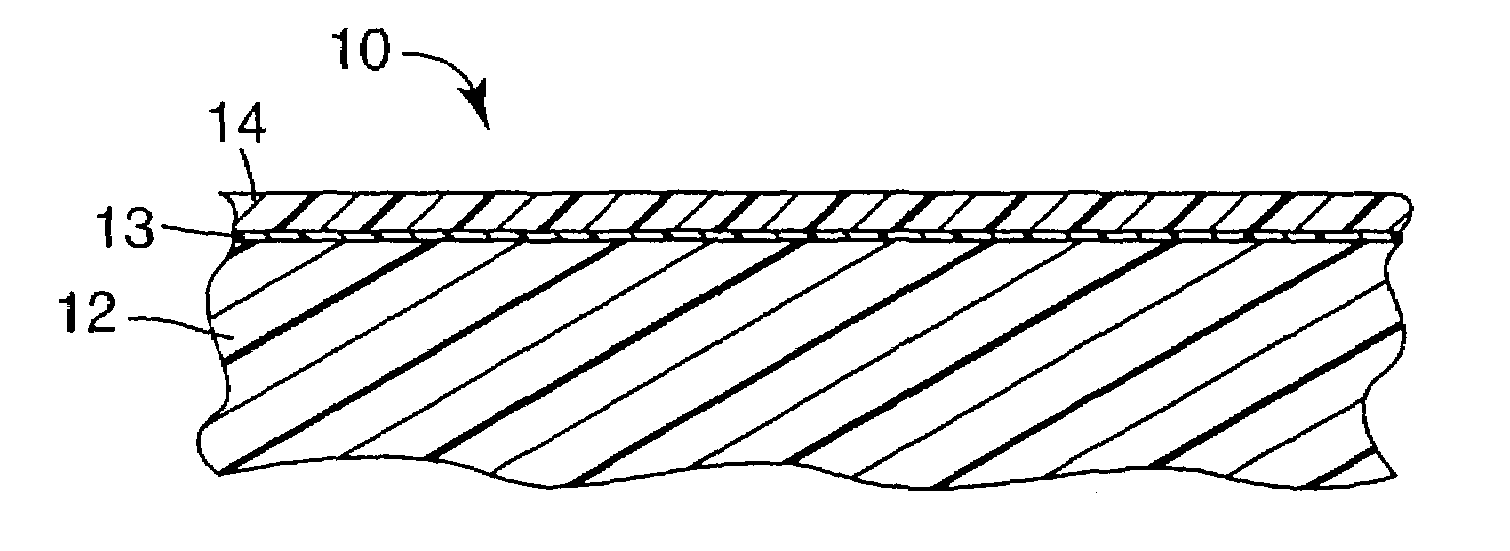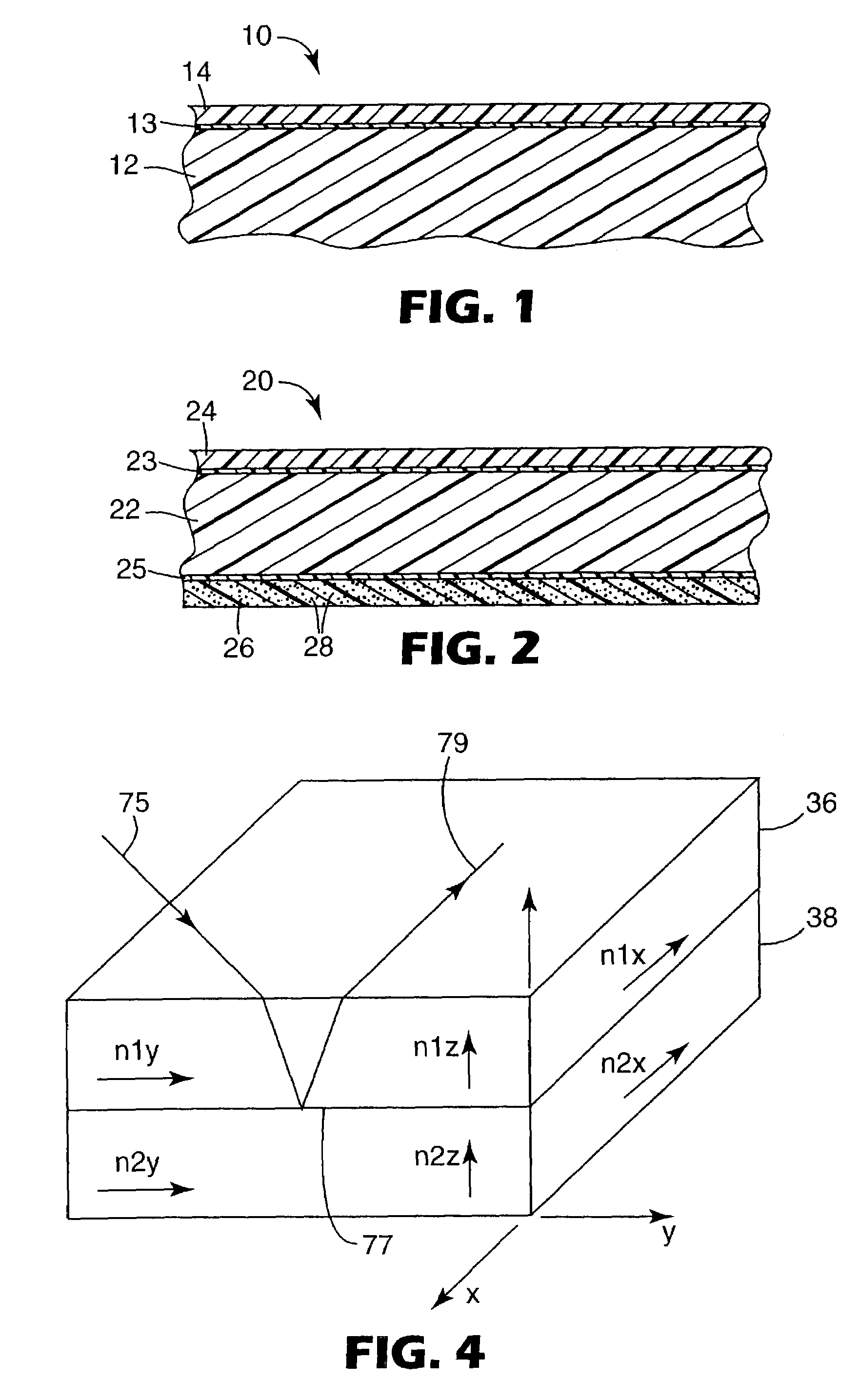UV resistant naphthalate polyester articles
a technology of naphthalate polyester and resistant to ultraviolet light, which is applied in the direction of synthetic resin layered products, transportation and packaging, coatings, etc., can solve the problems of undetected prone to degradation and compromise of polymerization of naphthalate polyester articles, and achieve the effects of prolonging the life or protecting the article, limited solubility of naphthalate polyesters, and high loading levels
- Summary
- Abstract
- Description
- Claims
- Application Information
AI Technical Summary
Benefits of technology
Problems solved by technology
Method used
Image
Examples
examples 13 – 20
EXAMPLES 13–20
[0067]Using the method of Example 1, the solubility of a variety of benzotriazoles in isobornyl acrylate was determined. The formula for each of the tested benzotriazoles is set out above. These benzotriazoles can also be represented using the general structure 2-(2-hydroxy-3-R2-5-R3-phenyl)-5-R1-benzotriazole. For CGL-139, R1=trifluoromethyl, R2=alpha-cumyl, and R3=t-octyl. For TINUVIN 928, R1=H, R2=alpha-cumyl, and R3=t-octyl. For Tinuvin 328, R1=H, R2=t-amyl, and R3=t-amyl. For TINUVIN 327, R1=chloro, R2=t-butyl, and R3=t-butyl. For TINUVIN 326, R1=chloro, R2=t-butyl, and R3=methyl. For both TINUVIN 234 and TINUVIN 900, R1=H, R2=alpha-cumyl, and R3=alpha-cumyl. The results are set out below in Table 2.
[0068]
TABLE 2BenzotriazoleExample48 hr Solubility,No.UV Absorberwt. %13TINUVIN 92830–35%14CGL-13925–30%15TINUVIN 32820–25%16TINUVIN 327 / 92810–15%(50:50 Blend)17TINUVIN 326 5–10%18TINUVIN 327 5–10%19TINUVIN 900 0–5%20TINUVIN 234 0–5%
[0069]As shown in Table 2, very high ...
examples 21 – 48
EXAMPLES 21–48
[0070]Several coating compositions were prepared by adding varying amounts of CGL-139 benzotriazole to mixtures containing isobomyl acrylate (“IBOA”, obtained as SR-506 from Sartomer Company), hexanediol diacrylate (“HDODA”, obtained as SR-238 from Sartomer Company), pentaerythritol tetraacrylate (“PETA”, obtained as SR-295 from Sartomer Company), and urethane acrylate oligomer (“UA”, obtained as CN966B85 from Sartomer Company in a blend believed to contain 85% urethane acrylate oligomer and 15% HDODA) or an optional silane-treated colloidal silica hydrosol.
[0071]The silane-treated colloidal silica hydrosol was prepared as the reaction product of NALCO™ 2327 silica hydrosol (commercially available from Ondeo Nalco Co.) with 3-(trimethoxysilyl)propyl methacrylate (obtained as A174 from Sigma-Aldrich Co.) in the presence of 1-methoxy-2-propanol (commercially available from Dow Chemical Co.). 400 Parts of the hydrosol were charged to a reaction vessel. 450 Parts of the 1-...
example 63
[0080]A coating solution was prepared in which butanediol diacrylate served both as the vinyl functional crosslinkable film former and as the solubilizing monomer. 13.58 Parts SR-213 (1,4-butanediol diacrylate), 2.72 parts CGL-139 (UVA), 0.17 parts TINUVIN 123 (HALS), 0.17 parts IRGACURE 819 and 0.34 parts IRGACURE 184 (photoinitiators), 0.02 parts TEGO RAD 2100 (leveling agent), and 3 parts ethyl acetate (solvent) were combined and blended until the solids had dissolved. This corresponded to a CGL-139 loading of 16.0% of the total coating solids. The solution was coated onto a PVdC primed VM2000 film (commercially available from 3M). The solvent was flashed off at 70° C. The coating was cured under nitrogen using a FUSION D-bulb. One specimen of the coated article was left at room conditions for one week. The specimen exhibited no blooming during this time. Two additional specimens of the coated article were oven treated at about 100° C. for one week. One specimen was allowed to ha...
PUM
| Property | Measurement | Unit |
|---|---|---|
| Fraction | aaaaa | aaaaa |
| Percent by mass | aaaaa | aaaaa |
| Percent by mass | aaaaa | aaaaa |
Abstract
Description
Claims
Application Information
 Login to View More
Login to View More - R&D
- Intellectual Property
- Life Sciences
- Materials
- Tech Scout
- Unparalleled Data Quality
- Higher Quality Content
- 60% Fewer Hallucinations
Browse by: Latest US Patents, China's latest patents, Technical Efficacy Thesaurus, Application Domain, Technology Topic, Popular Technical Reports.
© 2025 PatSnap. All rights reserved.Legal|Privacy policy|Modern Slavery Act Transparency Statement|Sitemap|About US| Contact US: help@patsnap.com



